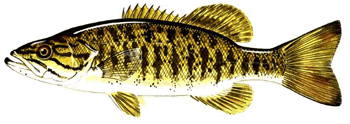Back to Previous Page
SMALLMOUTH BASS

At-a-Glance
- Scientific Name: Micropterus dolomieu
- Found in Illinois: Typically found in the northern third of the state and most often in flowing waters
- State Average: 10"
- State Record: 7 lbs/3 oz (2019)
- Best Lures: On the fly: Dry or wet flies, streamers, buck tails, poppers, hairbugs. Spin cast: Rooster tails, small spoons, jigs, live bait (e.g., crayfish, frogs, minnows, hellgrammites), plastic worms.
- Top 3 Lakes (based on average size): Fox Chain, Powerton,
- Top 3 Rivers (based on average size): Kankakee, Fox, Rock
Light to medium spin-casting outfit with 4 – 10 pound test fishing line.
In spring and early summer, use baits that imitate baitfish: white and silvery tubes, twister tail jigs and spinners.
Use crankbaits and plastics that imitate crayfish. Retrieve with a motion that will allow the bait to hit the bottom to simulate a swimming crayfish. Chartreuse jigs with spinners are also good.
Smallmouth are also an excellent for fly-fishing. For lots of tips on fly-fishing for smallmouth bass, watch this series of Orvis videos, featuring bass expert and Illinois Natural History scientist, Dr. David Philipp.
http://howtoflyfish.orvis.com/video-lessons/chapter-two-bass-fly-fishing/273-lures-vs-flies-for-bass
http://howtoflyfish.orvis.com/video-lessons/chapter-two-bass-fly-fishing/276-where-to-fish-for-bass
http://howtoflyfish.orvis.com/video-lessons/chapter-two-bass-fly-fishing/282-fly-retrieves
Habitat:
Typically found in streams with noticeable current and gravel or rock bottoms and in reservoirs with steep drop-offs and rocky shorelines. Unlike largemouth bass, smallmouths typically do poorer in smaller lakes and reservoirs that have soft substrate and abundant vegetation.
Feeding and Habits:
Smallmouth bass feed primarily on crayfish and other small crustaceans, insect larvae and larger insects, but they will also eat small fish and flying insects that land on the water's surface.
Reproduction:
Similar to largemouth bass, smallmouth bass males build the nests and provide all the parental care. Spawning begins in May when water temperatures are above 55°F. Nests are built in shallower waters and are constructed in gravel, coarse sand, or rock bottom. Males attract a female and herd her over the nest to spawn. The female will tip her body to deposit a few egg while the male releases a small amount of sperm, fertilizing the eggs. The eggs fall into the nest and are sticky so that they attached to the substrate in the nest. Once spawning has ended, the female leaves the area; the male is left to provide all of the parental care, which includes fanning the developing eggs to provide oxygen and enthusiastically defending the area to keep predators away. Eggs usually hatch in 2–4 days and the larvae remain in the nest for about 5–10 more days (depending on temperature). Smallmouth fry will become free swimming, but school above the nest with the male continuing his vigilant care.



